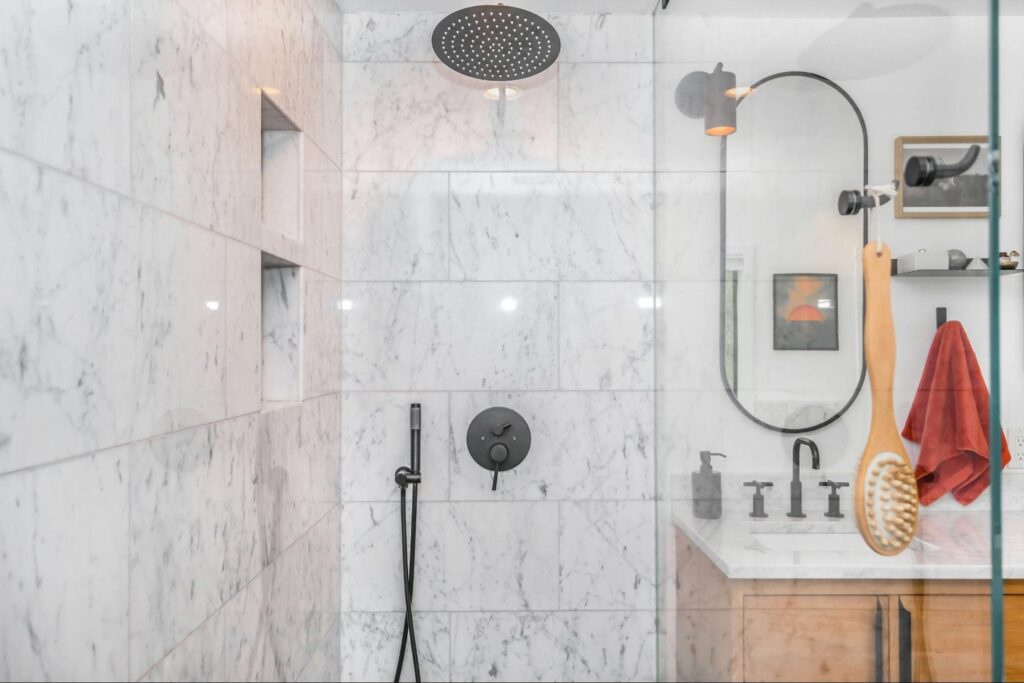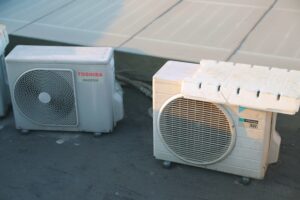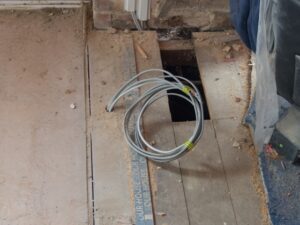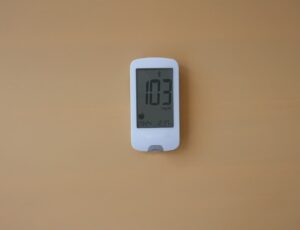Have you ever felt frustrated waiting for hot water to reach your faucet?
Wouldn’t it be amazing if you could enjoy hot water instantly, saving both time and water?
A water heater recirculating pump could be the perfect solution to this common household hassle. This simple yet innovative system ensures that hot water is always available at the right moment, creating a continuous loop of water between your heater and faucets, making your home more efficient and eco-friendly.
At Excel Mechanical, we specialize in installing and maintaining recirculating pump systems that cater to both residential and commercial needs. With our expertise, you don’t just get a product—you get a personalized solution tailored to your home or business.
Our team is committed to delivering high-quality HVAC and plumbing services, ensuring you enjoy the convenience and comfort that comes with a recirculating pump.
In this blog, you will learn:
- How a recirculating pump works and its benefits for your home
- The types of systems available and how to choose the right one for you
- Key installation and maintenance considerations to ensure your system runs smoothly
Let’s explore how a water heater recirculating pump can improve the comfort and efficiency of your home.
Understanding Water Heater Recirculating Pumps
Water heater recirculating pumps provide quick access to hot water by moving it efficiently between the heater and faucets. These pumps save water and offer convenience to homeowners.
Definition and Basic Function
A water heater recirculating pump moves hot water through your pipes, reducing wait times at your faucets. Instead of running the tap and wasting water until it heats, the pump creates a continuous loop of hot water, ensuring it’s readily available.
They typically use a small pump attached to the water heater. Some systems feature a temperature sensor that activates the pump only when needed, which increases efficiency and reduces energy consumption.
Types of Recirculating Pumps
There are a few types of recirculating pumps to consider:
- Dedicated Loop System: This type uses a separate hot water line that connects to the main plumbing loop. It requires more installation effort but provides instant hot water.
- Integrated Loop System: This option uses existing cold water lines to return unused hot water to the heater. It is less invasive and often more affordable.
- Point-of-Use System: This system heats water locally, and it is installed under a sink or fixture. It is best for isolated locations away from the main unit.
Selecting the right type depends on your plumbing setup and hot water needs.
Benefits of Using Recirculating Pumps
Water heater recirculating pumps offer several advantages:
- Time-Saving: Instantly access hot water without the wait.
- Water Conservation: Reduces water wastage by circulating unused hot water back to the heater.
- Energy Efficiency: Modern pumps only run when necessary, saving energy.
Installation Considerations
When installing a water heater recirculating pump, it’s crucial to choose the right model, ensure compatibility with your current system, and gather the necessary tools and materials.
This guide will help you understand each aspect to make the installation seamless and efficient.
Selecting the Right Pump
Choosing the correct recirculating pump is essential for efficient performance.
- Pumps come in different sizes and capacities. Consider the size of your household and the capacity of your water heater.
- If you have a large home, you may need a more powerful pump to ensure fast water circulation throughout the house.
- Check for features like a timer or a thermostat. These can help you conserve energy by running the pump only when needed.
- Also, look for a model that fits your budget and has a warranty for peace of mind.
Compatibility with Your Water Heater
Ensuring compatibility with your existing water heater is crucial.
Not all pumps work with every type of water heater, whether traditional tank models or modern tankless ones. Before purchasing, verify with the manufacturer if the pump suits your water heater type.
Tools and Materials Required
Having the necessary tools and materials ready will make installation faster and easier.
Basic tools include a wrench set, screwdriver, drill, pipe cutter, and Teflon tape. You might also need pipe fittings and valves.
Ensure you have the pump’s manual as well for reference. Preparing a checklist of items before you start can prevent delays in the process. Planning saves time and avoids multiple trips to the hardware store.
Excel Mechanical provides top-notch services for residential and commercial properties if you prefer professional installation. Our trained professionals ensure a quality installation that offers excellent value and meets your unique requirements.
Operating Principles
A hot water recirculating pump system ensures that hot water is always available at your taps. This system helps prevent water wastage and enhances convenience by maintaining a steady flow and temperature.
How Recirculating Pumps Work
The primary function of a hot water recirculating pump is to quickly move hot water between the water heater and your fixtures, like sinks and showers. It creates a continuous loop where hot water circulates back to the heater when not needed, providing instant access to hot water.
Efficient systems incorporate a timer or sensor. These components automatically start the pump when temperatures drop, reducing energy use by only operating when necessary.
Temperature Maintenance
Consistent water temperature is crucial, and recirculating pumps help achieve this by keeping the water hot within the pipes. Maintaining a set temperature prevents the discomfort of cold water bursts during showers or when washing hands.
Temperature settings can often be adjusted, offering flexibility based on your preferences. A good system considers your household’s hot water habits, ensuring everyone has a comfortable experience.
Flow Patterns and Control
Managing flow patterns is essential for the efficiency of a recirculating pump system.
These pumps can be controlled to run during peak usage times, ensuring that hot water is available without delay. For improved performance, they might also include a thermostat or a dedicated return line.
Control systems can be simple manual switches or advanced programmable timers. These control options help save energy and water by operating the pump only when needed.
Good control and flow patterns mean you can enjoy seamless hot water delivery tailored to your schedule and needs.
Energy Efficiency and Cost Implications
When considering a water heater recirculating pump, consider energy savings, utility bill impacts, and maintenance costs. This information helps you make an informed decision.
Energy Savings Potential
Using a recirculating pump can save both time and water.
By ensuring hot water is ready, you’ll waste less water waiting to heat up. Besides conserving water, the design keeps energy use lower than reheating cold water. Modern pumps are more efficient and run on demand.
Choosing the right system minimizes energy waste.
Impact on Utility Bills
Although a recirculating pump needs electricity, the savings on water and heating costs often balance it out.
Efficient pumps avoid operating unnecessarily, keeping power consumption in check. The pump’s timing settings can align with your typical water use.
By tailoring the pump’s schedule, you reduce waste and improve your bill’s bottom line.
Pump Lifespan and Maintenance Costs
The lifespan of a recirculating pump depends on usage, water quality, and maintenance.
Regular checkups extend the pump’s life and avoid unnecessary repairs. Maintenance typically involves inspecting seals and replacing worn parts.
Quality equipment lasts longer, reducing the need for frequent replacements. Although periodic maintenance has a cost, frequent upkeep ensures reliability. Choosing high-quality products and professional installation from a trusted provider helps lower costs over time.
Maintenance and Troubleshooting
Keeping your hot water recirculation pump in good working order ensures efficiency and extends its lifespan. Below, find detailed guidance on routine maintenance tasks, common problems and fixes, and when professional assistance is needed.
Regular Maintenance Tasks
Routine maintenance is essential for optimal performance.
- Start by checking the pump for any visible signs of wear or leaks.
- Clean any debris blocking the impellers, which can hinder water flow.
- Regularly inspect connections and seals to ensure there are no leaks. Tightening loose connections can prevent future issues.
- It’s also important to periodically test the system’s check valve to ensure it functions correctly and stops water from flowing backward.
- Setting a schedule to flush your water heater routinely can remove sediment buildup. This improves efficiency and extends the life of both the heater and pump.
Common Issues and Solutions
Issues can occasionally arise with your recirculation pump.
- If you notice strange noises, it could indicate trapped air in the system. Bleeding the pump to remove air should resolve this.
- If hot water isn’t reaching your faucets, there may be a fault in the thermostat or timer or a problem with the pump’s power supply. Check and reset these components as needed. An unresponsive pump might indicate a burned-out motor; replacing it may be necessary.
- Regular wear and tear can cause leaks or decreased pump efficiency. In such cases, checking seals and gaskets can be helpful.
Replacing defective parts often restores normal function.
When to Call a Professional
While some maintenance can be handled yourself, specific problems require expert help.
Call a professional if your pump continues to malfunction despite troubleshooting efforts. Persistent leaks, electrical issues, or significant corrosion are signs that a trained technician should inspect your system.
Excel Mechanical specializes in HVAC and plumbing services, offering quality and value for residential and commercial needs. Professional assistance ensures reliability in cases of complete system failures or new installations.
With us, you receive a system designed to fit your requirements and budget, ensuring optimal function and satisfaction.
Regulations and Best Practices
Knowing the key regulations and best practices when installing a water heater recirculation pump is crucial. This helps ensure efficiency, safety, and compliance.
Building Codes and Standards
Following building codes and standards is fundamental for installing a water heater recirculation pump. Different regions have specific requirements that dictate how these systems should be integrated.
For instance, some areas require specific types of pipes or pumps to meet safety and efficiency standards. You must also ensure that all electrical connections and components comply with local regulations to prevent hazards.
Proper installation not only ensures safety but also prolongs the life of your system. Consulting professionals guarantee compliance and optimal performance, given their residential and commercial systems expertise.
Environmental Considerations
Environmental considerations play a significant role when installing recirculation pumps. These systems reduce the amount of water wasted while waiting for hot water, aligning with eco-friendly practices.
Select energy-efficient pumps to minimize your carbon footprint. Regulations may also mandate specific measures to limit energy consumption and water usage.
Opting for systems that conserve resources and maintain performance is vital.
Choosing and Purchasing a Recirculating Pump
When selecting a recirculating pump, focus on factors like brand reliability, available purchasing options, and the support you’ll receive after your purchase. Consider how each brand’s features and performance compare, where to purchase, and what kind of warranty can protect your investment.
Brand and Model Comparisons
Choosing the right brand and model can directly impact performance and longevity.
Look for brands that are known for efficiency and durability. Compare specifications such as power consumption, flow rate, and noise levels. Some popular features to consider are adjustable speed settings and smart controls.
Read reviews and customer feedback to gauge real-world performance.
Where to Buy
You have a variety of places where you can purchase a recirculating pump.
- Specialized HVAC and plumbing stores often carry a range of options, allowing customers to see products up close.
- Online platforms like Amazon and Home Depot allow for comparison shopping and offer customer reviews to help make informed decisions.
If you prefer expert guidance, we can assist with selecting and installing the perfect pump for residential and commercial applications, prioritizing your unique needs and budget.
Warranty and Support Options
Consider the warranty and support options available when investing in a recirculating pump.
A good warranty can provide peace of mind, covering crucial components for several years. Some brands offer extended warranties for an additional fee, which might be worthwhile.
Also, consider the support available, such as customer service, installation help, and repair services.
Frequently Asked Questions
You might have a few questions about how a hot water recirculating pump can work in your home, and that’s perfectly normal! What’s the real impact of installing one of these systems? Is it worth the investment? Let’s break down some of the most common questions we get to help you make an informed decision.
How is a hot water recirculating pump installed?
Installation typically involves connecting the pump to your water heater and creating a loop in the plumbing system. Some systems may require an additional return line, while others use existing pipes. It’s recommended to have a professional, like those from Excel Mechanical, handle the installation for optimal performance and safety.
Can a recirculating pump be added to any water heater?
Yes, most water heaters can accommodate a recirculating pump. However, compatibility may depend on your home’s plumbing configuration. It’s best to consult with a professional to ensure your system is suitable for a recirculating pump. Experienced technicians can evaluate your setup and make necessary adjustments.
What are the advantages and drawbacks of using a hot water recirculating pump?
A key advantage is reduced water waste, as hot water is available instantly. This can also lead to lower utility bills. On the downside, these pumps can increase energy use because they keep water hot in the pipes. Balancing the system with a timer or sensor can help manage energy use effectively.
How does a hot water recirculating pump function?
The pump moves hot water from the heater to the fixtures and back, keeping the water in constant circulation. This prevents cold water from sitting in the pipes, ensuring that hot water is readily available when you need it.
Is it cost-effective to install a recirculating pump on a water heater?
Installation can be cost-effective because it reduces water waste and may lower water bills. Initial costs may vary, but the savings from reduced water usage can offset the investment. Consulting with experts like Excel Mechanical can provide more insights into potential savings based on your situation.
Does a hot water recirculating pump need to operate continuously?
No, most models do not need to run continuously. Many pumps have timers or sensors that operate only when needed. This feature helps save energy and reduce system wear. Using these settings can optimize your pump’s performance and efficiency.




